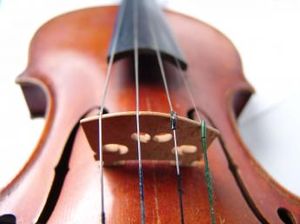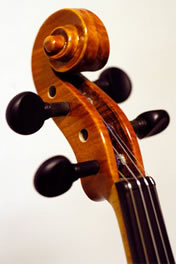The violin is a stringed musical instrument comprising four strings
tuned a fifth apart. It is the smallest and highest-tuned member
of the violin family of string instruments, which also includes
the viola, cello and double bass. The lowest string (and hence the
lowest note) is the G just below middle C, then in ascending order
D, A and E.
Sheet music for a violin almost always uses the G clef
(treble clef).
Parts of the Violin
The violin is a carefully made hollow wooden box, with a neck protruding
from the top, and a internal sound post connecting the front (belly)
and the back. The sides of the violin, curiously, are called ribs.
The belly is reinforced by an internal bass bar, which runs vertically
through the instrument underneath the lowest string.
 The
four violin strings run from a tailpiece attached to the base of the violin,
across an intricately carved wooden bridge, then upward just above
the fingerboard. At the top end of the fingerboard, the strings
cross the nut, a very small second bridge, mounted just slightly
above the fingerboard. They then enter the pegbox, where they are
wound around their tuning pegs, which are mounted sideways through
tightly fitting holes in the pegbox. The tip of the pegbox is ornamented
with a carved wooden scroll.
The
four violin strings run from a tailpiece attached to the base of the violin,
across an intricately carved wooden bridge, then upward just above
the fingerboard. At the top end of the fingerboard, the strings
cross the nut, a very small second bridge, mounted just slightly
above the fingerboard. They then enter the pegbox, where they are
wound around their tuning pegs, which are mounted sideways through
tightly fitting holes in the pegbox. The tip of the pegbox is ornamented
with a carved wooden scroll.
The bridge of a violin has two purposes. First, it holds the strings
in an arched configuration, permitting each to be touched separately
by the bow. The bridge also transmits the sound vibrations of the
strings to the belly, from which they are transmitted to the back
by the sound post.
>> See how a violin is made
Materials of the Violin
Generally the belly, the sound post, and the bass bar are made of
spruce, a light but strong softwood. The back, ribs, neck, pegbox,
scroll, and bridge are of maple, a hardwood. The choice of woods
is basically the same as in the piano, where a hardwood bridge is
attached to a spruce soundboard, mounted on a hardwood frame.
bridge is
attached to a spruce soundboard, mounted on a hardwood frame.
The fingerboard of a violin is of ebony. Some old violins have
ivory fingerboards.
Strings were originally made of gut. Such strings are still often
used in historically accurate performances of music from the 18th
century and earlier. However, they have a tendency to go out of
tune and snap more easily than modern strings, which are made from
metal. Modern A, D and G strings are usually metal-cored and wound
with metal for greater mass in order to vibrate at a lower pitch,
with the E (top) string being a metal mono-filament of steel. Synthetic
cored strings (wound with metal) are also employed today; they combine
some of the benefits of gut strings with greater longevity and tuning
stability.
The hair of the bow is traditionally horse hair, although many
cheaper bows use synthetic material. The hair must be frequently
rubbed with rosin in order to grip the strings and cause them to
vibrate.
Playing the Violin
The violin is played by using the right hand to draw the bow at
right angles across one of the strings, near the bridge, causing
the string to vibrate. Pitch is controlled by selecting the string
that the bow contacts (by altering the vertical angle of the bow),
and by regulating the sounding length of that string by pressing
it down onto the fingerboard with one of the fingers of the left
hand.
Fingering and Positions
The placement of the fingers on the strings invokes no physical
aid like frets; the player must achieve the correct position from
skill alone, or else the instrument will sound out of tune. Violin
players practice long hours partly to train their fingers to land
in the right places, and partly to cultivate the ability to correct
the pitch very rapidly as it is played.
The fingers are conventionally numbered "first" (index)
through "fourth" (little finger). The digits 1-4 sometimes
appear over the notes in violin music, especially in instructional
editions, to indicate the finger to be used.
For the beginning player, the highest note available on a violin
is made by pressing the fourth finger down on the E-string, sounding
a B. However this is only the highest note in so-called first position,
which is taught to beginners first. A higher note can be achieved
by sliding the hand up the neck of the violin (towards the player's
face) and pressing the fingers down at this new position. Thus,
for example, in first position, the first finger placed on the E
string gives an F#. Pressing the first finger instead on a G is
called second position. Third position is achieved when the first
finger presses down on an A, and so on. The upper limit of the violin's
range is largely determined by the skill of the player. A good player
can easily play more than two octaves on a single string, and four
octaves on the instrument as a whole.
Violinists often change positions on the lower strings even though
this seems unnecessary. Often, this is done to handle a musical
passage which would otherwise require fast switching of strings.
It is also done to produce a particular timbre: a violin note will
sound different depending on what string is used to play it.
Open Strings
A special timbre results from playing a note without touching its
string with a finger, thus sounding the lowest note on that string.
Such a note is said to played on an open string. Open string notes
(G, D, A, E) have a very distinct sound resulting from absence of
the damping action of a finger, and from the fact that
vibrato (see
below) is impossible. Other than low G (which can be played in no
other way), open strings are usually selected for special effects.
One striking effect that employs open strings is barriolage. Here,
the player fingers the same note of an open string (necessarily
D, A, or E) on the immediately lower string, then moves the bow
with a rapid snake-like motion that causes it to touch the fingered
string and the open string alternatingly. The same pitch is thus
sounded, but the different timbres of an open string vs. a fingered
string produce an audible rhythmic pulsation. Barriolage was a favorite
device of Joseph Haydn, who used it for example in his string quartet
Opus 50 no. 6, and in the "Farewell" Symphony.
Playing two open strings simultaneously (that is, double stopped;
see below) produces a bagpipe-like drone, often used by composers
in imitation of folk music.
Double-Stopping
Double stopping is playing two strings simultaneously, producing
a chord. This is much harder than normal single-string playing as
more than one finger has to be accurately placed on two different
strings simultaneously. Sometimes moving to a higher position is
necessary in order for it to be physically possible for the fingers
to be placed in the correct places. Double stopping is also used
to mean playing on three or all four strings at once, although such
practices are more properly called triple or quadruple stopping.
Collectively, double, triple and quadruple stopping is called multiple
stopping.
See Double stop for general information about the techniques of
double stopping and bowing.
>> Learn about Pizzicato
>> Learn about Vibrato
Harmonics
Pressing the finger very lightly on the string can create harmonics.
This means that instead of the normal solid tone a wispy-sounding
note of a higher pitch is heard. This is caused by the light finger
blocking the string's fundamental; the position of the finger determines
the first note of that string's harmonic series which is allowed
to sound.
Bowing Techniques
The violin produces louder notes when the player either moves the
bow faster or pushes down harder on the string. The two methods
are not equivalent, because they produce different timbres; pressing
down on the string tends to produce a harsher, more intense sound.
The location where the bow intersects the string also influences
timbre. Playing close to the bridge (sul ponticello) gives a more
intense sound than usual, emphasizing the higher harmonics; and
playing with the bow over the end of the fingerboard (sul tasto)
makes for a delicate, ethereal sound, emphasizing the fundamental
frequency.
Occasionally the strings are struck with the back of the bow (col
legno). This gives a much more percussive sound, and is most effective
when employed by a full orchestral violin section, since it produces
little volume.
A second, more modern percussive technique is called the "chop,"
in which the hair near the bottom of the bow is struck against the
strings.
>> Watch videos of bowing techniques
Tuning the Violin
Violins are tuned by twisting the pegs in the scroll, around which the strings are wrapped. The A string is tuned first, typically to 440 Hz (see Pitch (music)). The other strings are then tuned to it in intervals of perfect fifths using double-stopping. Some violins also have adjustors (also called fine tuners). These permit the tension of the string to be adjusted by rotating a small knob. Such tuning is generally easier than using the pegs, and adjustors are usually recommended for younger players. Adjustors work best, and are most useful, with higher tension metal strings. It is very common to use one on the E-string even if the others are not equipped with them.
Small tuning adjustments can also be made by stretching a string with the hand.
The tuning G-D-A-E is used for the great majority of all violin music. However, other tunings are occasionally employed (for example, tuning the G string up to A), both in classical music (where the technique is known as scordatura) and in some folk styles.
>> More informatino on tuning

